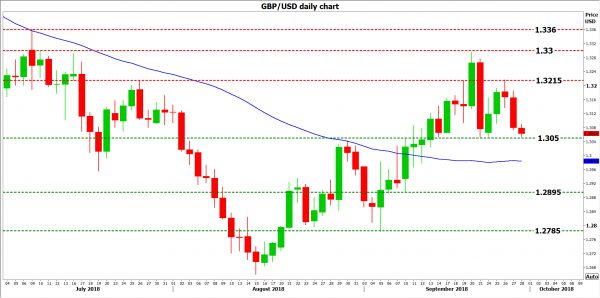All roads will lead to Birmingham on Sunday, where the UK’s ruling Conservative Party will hold its annual three-day conference to map out its political strategies. With the coming weeks being the make-or-break period for reaching a Brexit deal, sterling will likely be ultra-sensitive to any remarks around the negotiations, as well as any hints that Theresa May’s leadership could be challenged moving forward.
While this conference will cover a wide range of topics, the financial community will have its gaze locked on anything Brexit-related, as the negotiations are now entering their final stretch. Another (crucial) point to watch is whether the hardline Brexiteers within the party will seek to challenge Theresa May’s leadership. While this group may not go as far as launch a leadership contest at the conference itself, the tone of their remarks will still be important, as they could attempt to set the stage for a “coup” later on in case they are dissatisfied with any “soft” deal she brings back to Parliament. Specifically, the comments of key ministers on May’s Chequers plan, which she has insisted remains the main basis for negotiations despite discontent among Brexiteers, will be closely eyed.
As for the potential ramifications on sterling, the worst-case scenario would probably be an immediate leadership challenge, especially by a popular Tory figure like Boris Johnson. Political uncertainty would reach new heights in such a case, not least due to the possibility the process drags on, rendering the government leaderless at a time when all efforts should be concentrated on the exit talks. Equally, replacing May with someone that may have vastly different ideas could reduce the chances of any deal, considering the scarcity of time.
Of particular interest will be any mention to the recently-leaked EU documents suggesting the EU and UK could establish “free trade areas” between them, and that Northern Ireland could be among these areas. While this suggestion may fall short of solving the Irish border issue entirely, it would certainly mark progress on what is probably the biggest sticking point left. Hence, the best-base scenario for sterling may be any potential hint from core Tories that this would be an acceptable compromise, or at least a starting ground for negotiations.
On the possibility of a second referendum, which the opposition Labour Party recently “did not rule out” at its own conference, one shouldn’t hold their breath – as the Tory Party is nearly unanimous in opposing such action.
Technically, declines in sterling/dollar may encounter a first line of support near 1.3050, which halted the decline on September 21. A downside break could open the way for the September 10 low of 1.2895, before the September 5 trough of 1.2785 comes into view.
On the upside, resistance to advances could come around 1.3215, a zone marked by the highs of September 26. If the bulls manage to pierce it, advances could stall near the 1.3300 handle, the peak of September 20, ahead of the 1.3360 mark – this being the July 9 top.














